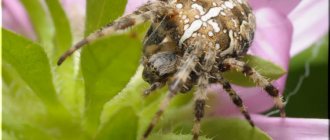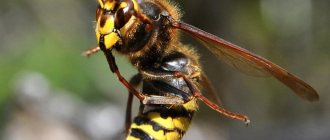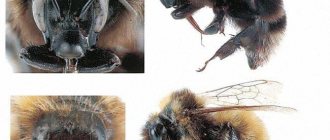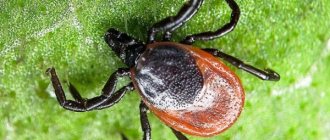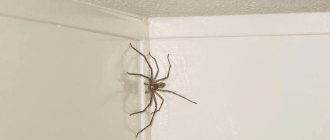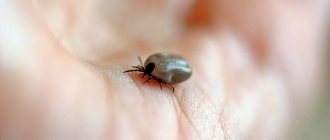Most spiders do not bite people, but others will only do so if provoked. The vast majority of spider bites cause only a mild reaction in people, such as minor swelling, inflammation or itching.
However, there are several poisonous spiders in Russia that can be dangerous. The venom these spiders use to kill their prey is also harmful to humans. The bite of a venomous spider can cause severe local and systemic reactions and can sometimes be fatal.
General information
A spider bite usually causes a painful condition in humans called arachnidism or aranidism .
It is characterized by various symptoms and consequences initiated by the toxic effect of a poisonous animal. The poison can be neurotoxic or necrotic. In addition, pathogenesis is associated with allergic reactions and infection introduced into the wound. A small number of spider species are poisonous. They are the most important entomophages, destroying a huge number of insects and other species harmful to the ecosystem. In the north and in the middle zone, poisonous spiders are not found.
Representatives of the families Theraphosida, Gnaphosidae, Linyphiidae, Micryphantidae are poisonous. Their toxicity may vary depending on the season, gender, age and environment.
Spiders next to a person
Spiders often inhabit people's homes. You should not be afraid of the house spider, because it is not dangerous to humans, but has woven a web to catch insects. They do not form populations and reproduce quite rarely, especially if there is not enough food. They live for about 2-6 months.
Types of house spiders
Why does a spider bite
Contrary to what many people think, spiders are not characterized by unmotivated aggressive behavior. Sensing danger, predators with a developed instinct of self-preservation try to run away and hide. Only if they can’t escape do they save their lives.
As a rule, the culprit of the attack is the person himself, accidentally or intentionally threatening the life of the arthropod: trying to kill it, finding it on his clothes/skin, disturbing its habitat, and so on. It is important to understand that spiders sense a threat on a biological level and defend themselves as best they can.
Pathogenesis
The pathogenesis is based on the toxic effect of poisons - neurotoxic and necrotic (cytolytic), as well as the development of allergic and infectious reactions in response to a bite. Effects may be local only or with additional systemic reactions resulting from neurotoxicity.
The effect of spider venoms resembles strychnine , but is much weaker. After excitement, a loss of strength occurs and paralysis . The toxic complex biochemical mixture contains neurotoxic substances that paralyze the nervous system, as well as hemolytic substances that destroy the blood. Their main task is to kill and paralyze the victim, as well as protect and scare away the aggressor.
The mechanism of action of Latrotoxin, a component of most neurotoxic poisons
By its nature, it is a presynaptic neurotoxin, since the point of action of Latrotoxin is the presynaptic nerve ending. There, the dimeric toxin is able to contact protein receptors with a molecular weight of ~95,000, as a result of which the resulting complex induces the permeability of biomembranes and becomes a channel for calcium cations - triggering the release of neurotransmitters and accelerating this process by 1000-1500 times. When reserves are depleted, after 30-50 minutes a complete block of neuromuscular transmission occurs. This ultimately leads to overstimulation of the muscle motor neuron ganglia.
Classification
When bitten by a spider, it is very important to know what type of insect attacked you or your loved ones. It is best if you can photograph the spider, but in most cases you have to rely on developing clinical manifestations.
Cross spider bite
The spider's venom is generally toxic to arachnids and insects. Toxicity is determined by the location of administration - the closer to the ganglion, the stronger the effect.
Cross spider bites can cause
headache , weakness , arthralgia , colic and burning at the site of the bite with hemorrhages into the subcutaneous tissue. No deaths have been reported, but a spider bite after recovery quite often initiates a secondary infection and necrosis of soft tissue in the area of penetration of the venom. The eggs themselves and the body of the spider, especially at the egg-laying stage, contain a toxic substance - epeirotoxin .
Black widow bite
More people on the planet died from black widow bites than from all other spiders combined, so even the pathological condition they caused was given a name - latrodectism .
The black widow's bite is neurotoxic, only females bite, and feels like a pinprick. In appearance, the bite site is characterized by two points, slight redness and swelling without the formation of necrotic wounds. The α-latrotoxin contained in the venom stimulates the release of mediators, acetylcholine , norepinephrine, etc. from presynaptic endings, causing subsequent depletion of their reserves. Before the onset of painful muscle spasms, 0.5-1 hour passes after the spider bite, and they subsequently spread to neighboring and large muscles, limbs and torso. A person feels a pronounced tension in the muscles of the anterior abdominal wall with painless palpation, but excruciating pain can cause a false suspicion of peritonitis .
External manifestations and behavior are distinguished by drooling , sweating , vomiting , hypertension , tachycardia , wheezing , anxiety , hyperreflexia , retention , muscle twitching, trembling, complaints of headache and weakness, changes in sensitivity, and in pregnant women contractions may begin prematurely childbirth _
Usually, after being bitten by a black widow, a person is in a hysterical and shocked state - running and screaming in pain. The pain usually subsides within the first 12 hours, but may intensify again in the next 24 hours and manifest itself within a week.
Dangerous spider for humans - black widow
Death usually occurs as a result of respiratory arrest or hemorrhagic stroke , failure of cardiac function, especially in young, elderly and debilitated patients.
Karakurt bite
Karakurt poison has a neurotoxic effect and has similar symptoms as in black widows. After a burning sensation in the area of the bite, redness and swelling occurs on the body, as well as pain that spreads radially to the abdomen, lower back and chest, so the condition is easily confused with myocardial infarction. General poisoning is manifested by shortness of breath , increased heart rate , dizziness , headache , tremor , vomiting , pallor, or, on the contrary, facial hyperemia , sweating , priapism , bronchospasm , exophthalmos and mydriasis , as well as delayed urination and defecation. The later stages of poisoning are characterized by a change from psychomotor agitation to deep depression , blackouts and delirium.
Tarantula bite
The venom of the tarantula is considered less powerful than the karakurt. Its rather large body is 5-7 centimeters and its paws are covered with hairs. Color ranges from dark brown to black.
The sting resembles a bee sting and is not fatal. At the site of the lesion, pain, slight swelling and swelling of the tissues occur. It is possible to develop general toxicemia , accompanied by heaviness in the body , chills , apathy , lethargy and drowsiness , which disappear on their own after a few days.
Silver Spider Bite
A separate species of spiders living in aquatic environments is common in Europe. It poses a danger to humans, as it can bite when caught during fishing with fish or when it reaches the shore. And despite the fact that a spider bite is just self-defense, its venom in people prone to allergies can cause an inflammatory reaction and severe allergic symptoms, manifested by weakness, nausea , dizziness , headache, and fever. Clinical manifestations disappear after a few days. To speed up the therapeutic effect, it is enough to take an antihistamine.
Tartar spider bite
If an allergic reaction does not develop after the bite of a tarantula spider, then its venom usually does not cause much harm to a person. It is comparable to wasps and bees.
The main allergen is “protective stinging hairs,” which can get on the skin or mucous membranes of a person and cause unbearable itching, pain when it gets into the eyes, suffocation and general weakness.
Folk remedies for bites
To eliminate unpleasant symptoms and accelerate the healing of the epidermis, use:
- Vinegar solution. For a glass of water, 1 teaspoon of the product. Treat the bite site.
- Baking soda paste. Dilute with water to a paste.
- Juice of lemon, orange, cucumber, onion, parsley, potato, as well as dandelion, plantain, celandine.
- Toothpaste, shaving foam. Apply to the bite site for 5 minutes and wash off.
- Aloe vera leaves or juice.
They are used for minor manifestations of allergies or as an aid.
Causes
The main pathogen is toxins secreted by the mouthparts (chelicerae) of spiders:
- neurotoxic poisons (Δ-atracotoxin of the most dangerous Australian spider Atrax robustus, α-latrotoxin of the black widow and karakurt) have a direct effect on the structures of the central nervous system of the attacked individual by such representatives of spiders as karakurt and black widows;
- necrotic poisons (containing the dermonecrotic substance sphingomyelinase) are produced by spiders of the sicariid family.
It is important to remember that spiders themselves do not attack people or large animals. In dangerous situations, they prefer to flee. Worse, if a person is caught in a web or a tenet cocoon designed to catch insects, then the spider may instinctively attack the victim. However, most often spiders bite people when they accidentally crush or step on them. It is important to know that the most dangerous representatives of spiders are the Australian species Atrax robustus, since they tend to climb into human dwellings - cool and damp, where they establish their homes and trapping nets for fairly large insects and animals.
Male and female Atrax robustus
Which spiders are dangerous
Many spiders bite, but very few are dangerous to humans. The following common spiders are poisonous:
• black Widow; • brown recluse spiders; • tarantulas.
The venom of black widow spiders is a neurotoxin (dangerous to the nervous system).
Brown recluse venom causes necrosis of skin and tissue.
Tarantulas have body hairs and hind legs that can pierce human skin and inject a toxin. They usually do not bite unless threatened. Tarantulas are large hairy spiders with a leg span of up to 25 cm.
Symptoms of a spider bite
Local manifestations and skin lesions usually consist of wound redness and itching, joint and muscle pain (arthralgia and myalgia), but spider bites can provoke the development of systemic disorders within a few hours and even minutes, including:
- increase in temperature, up to intense heat;
- chills;
- vomit;
- abdominal pain;
- dizziness;
- profuse sweating;
- priapism;
- hallucinosis;
- convulsions;
- hyperreflexia;
- in severe cases, coma and even death can occur.
Symptoms of a karakurt bite are similar to the clinical picture described above. depression , clouding of consciousness and delirium may occur .
What does a spider bite look like?
A spider bite usually does not look too scary; in addition to redness (erythema) and swelling, you can see two red or burgundy dots.
As you can see in the photo of a spider bite on a person’s hand, a local inflammatory reaction and necrotic processes occurred.
Necrosis after a spider bite
Arachnoism cutaneous
A spider bite can cause dermatosis - the so-called cutaneous arachnoidism , manifested by local hyperemia and edema, urticarnovesicular rashes. Local symptoms may develop against the background of cramps and diarrhea.
Severe disorders occur when bitten by spiders of the Lactodectus mactans and Loxosceles species.
Treatment
After a bite, you must seek qualified medical help, since severe intoxication is associated with a high risk of death. If there is a suspicion of a bite from a poisonous arthropod, the patient is admitted to the hospital for observation and treatment.
If the spider species is identified, an antidote can be administered. To stabilize the condition and remove toxins, complex detoxification therapy is carried out. To reduce allergic reactions, antihistamines are prescribed. The following methods are often used:
Zodak
- Suprastin.
- Zodak.
- Tavegil.
- Claritin.
- Diphenhydramine.
- Cetrin.
- Loratadine.
Drugs are prescribed to eliminate existing symptomatic manifestations. For severe headaches and muscle pain and inflammation, antispasmodics, analgesics and non-steroidal anti-inflammatory drugs are prescribed. Frequently used means:
- Spasmalgon.
- Spazgan.
- Maxigan.
- Analgin.
- Nimesil.
- Nurofen.
- Nimesulide.
- Diclofenac.
- Ibufen.
If there is a sharp increase in blood pressure, antihypertensive drugs are prescribed. When the necrotic process begins, surgical intervention is required to cleanse the existing wound.
First aid
Despite the fact that local and systemic symptoms caused by a bite usually go away spontaneously after a few hours, it is still better to know and carry out a number of preventive measures to prevent the likelihood of complications. Remember that ambulance is especially necessary for elderly people, hypertensive patients, children and pregnant women.
What to do if bitten by a spider?
It is important for anyone to know what to do if they are bitten by a spider, because a few simple steps can help save a life:
- To be able to identify the spider, try to catch it or save its body if it was crushed;
- wash the bite site with soap and water and wipe with alcohol; in general, sterilization can be carried out by the same treatment as for an infected wound;
- immobilize the affected limb;
- do not apply pressure bandages, but apply something cold, such as ice;
- take an antihistamine to prevent an allergic reaction;
- According to some reports, if a karakurt is bitten, immediate cauterization of the bite site with a match head can help.
4.What to do after an insect bite?
If you are bitten by a bee on your hand, you should immediately remove all rings and other jewelry, and then try to pull out the sting. It is important to carefully remove the sac filled with poison using any hard object. At the same time, try not to pull the bag or press on it, as in this case you will only speed up the injection of the poisonous liquid.
People who are not prone to developing allergic reactions to wasp and bee stings should take a tablet of any antihistamine: Tavegil, Fenkarol, Parlazin, Suprastin, etc. It is also worth applying a lotion soaked in any antiseptic to the stung area, and then lubricate it with a soothing ointment. Act according to the circumstances. For example, if your hand is very swollen and the swelling does not disappear for a long period of time, apply a cold compress or ice to the affected area of skin. In such a situation, it would not be superfluous to take another antihistamine tablet.
It is important to monitor the condition of a person who has been bitten, as it can worsen at any time due to changes in blood pressure, an increase in body temperature, and the appearance of rashes on other areas of the skin. If necessary, you should call an ambulance.
Diet for spider bites
Hypoallergenic diet
- Efficacy: therapeutic effect after 21-40 days
- Timing: constantly
- Cost of products: 1300-1400 rubles. in Week
A spider bite can cause an allergic and inflammatory reaction, as well as hemolysis and decreased immunity, so the patient’s diet should be as gentle, balanced and healthy as possible. Drinking plenty of fluids is also recommended, so it would be good to base your menu on dishes such as:
- broths;
- liquid porridge;
- stewed vegetables and salads;
- fruit salads;
- dairy products;
- compotes and soothing herbal teas.
Complications and consequences of a spider bite
After being bitten, a person may develop eosinophilia . It is more typical for tarantulas, tarantulas and other types of tropical spiders, as well as scorpions.
The severe consequences of a spider bite are reduced to hemorrhages and secondary infection at the site of the bite. A tarantula bite can have irreparable consequences for a person, but more often the danger comes from pathogenic microorganisms on hooks and chelicerae that can get into the wound.
The most severe and rare consequences of a black widow bite, which lead to rhabdomyolysis and kidney failure . Also quite dangerous to human health are spiders of the genus Steatoda, otherwise called false black widows, since their bite causes steatodism (acute pain, fever for 2-48 hours).
The body's reaction to a spider bite
Local reactions are expressed by external symptoms. After a bite, a typical lesion is characterized by fang marks (leaving 1-2 separate entrances). Within a few minutes, local inflammation occurs, resulting in a bright red spot followed by induration. Sometimes this may be accompanied by the formation of new red plaques around. Localized swelling usually lasts 7-10 days.
In some cases, a more severe reaction called necrotizing local reactions can occur due to bites from certain species. In such cases, a bubble occurs, followed by the formation of an ulcer with a crater. Wound healing takes several weeks to form a scar.
Systemic reactions are internal inflammatory processes. Sometimes during bites, venom components can be introduced into the body in sufficient quantities to damage several systems. When this happens, most of the venom passes through the circulating lymph. Thus, nonspecific generalized systemic inflammation may occur, leading to symptoms such as:
- fever;
- muscle pain;
- fatigue;
- enlarged nodes.
Some types of arthropod predators cause blood clotting disorders.
Besides specific syndromes, the most dangerous is an allergic reaction either due to a direct bite or contact with spider hair. This happens in tarantulas. Symptoms can range from mild to anaphylactic reactions. The latter can be life-threatening and is considered a medical emergency.
